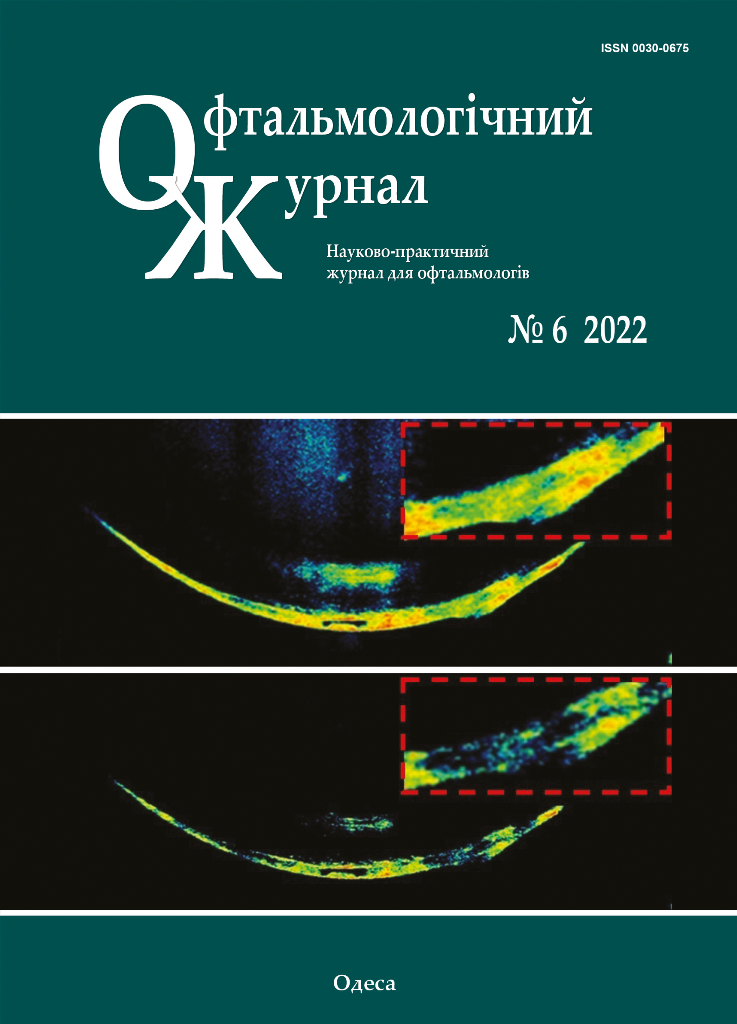Рідкісні нейрогенні (ретинальні) пухлини у дорослих: морфологічні особливості та проблеми діагностики
DOI:
https://doi.org/10.31288/oftalmolzh202263034Ключові слова:
внутрішньоочні пухлини, гістопатологія, імуногістохіміяАнотація
Актуальність. Гістологічна діагностика нейрогенних пухлин досі залишається серйозною проблемою. Про це свідчить хоча б той факт, що при кожному перевиданні класифікації ВООЗ уточнюються та з’являються нові найменування нейрогенних пухлин.
Мета дослідження – провести аналіз гістоморфологічних та імуногістохімічних особливостей рідкісних варіантів внутрішньоочних нейрогенних (ретинальних) пухлин у дорослих.
Матеріал і методи. Об’єктом дослідження були 6 внутрішньоочних пухлин серед дорослих, у морфологічній картині яких виявлені елементи нейрогенного диференціювання.
Результати. У наведеній добірці рідкісних внутрішньоочних нейрогенних пухлин у дорослих були виділені: новоутворення, близькі за імуногістохімічним профілем до клітинних епендимом, які за гістологічними патернами відповідні ретинобластомі; пухлини з імуногістохімічними маркерами нейроепітеліального диференціювання, але без класичної гістологічної картини диктіоми; новоутворення, з гістологічними патернами, близькими до попередніх пухлин, але якi мають імуногістохімічні маркери гліального типу.
Висновок. Очевидно, що при розподілі цих пухлин на гістогенетичні групи необхідно враховувати не тільки гістологічну будову та імуногістохімічний профіль, але також локалізацію та віковий оптимум.
Посилання
Louis DN, Ohgaki H, Wiestler OD, Cavenee WK, Burger PC, Bernd AJ, et al. The 2007 WHO Classification of tumours of the central nervous system. Acta Neuropathol. 2007; 114(2):97-109. https://doi.org/10.1007/s00401-007-0243-4
Gupta A, Dwivedi T. A simplified overview of World Health Organization classification update of central nervous system tumors 2016. J Neurosci Rural Pract. Oct-Dec. 2017; 8(4):629-641. https://doi.org/10.4103/jnrp.jnrp_168_17
Biswasm J, Manim B, Shaunmugen M. Retinoblastoma in adults: report of three cases and review of the literature. Surv Ophthalmol. 2000 Mar-Apr;44(5):409-14.
Mackley R.A. Retinoblastoma in a 52-year old man. Arch Ophthalmol. 1963 Mar;69:325-7. https://doi.org/10.1001/archopht.1963.00960040331013
Takahahi T, Namura S, Inoue M., Isayama Y, Sashikata T. Retinoblastoma in a 26-year old adult. Ophthalmology. 1983 Feb;90(2):179-83. https://doi.org/10.1016/S0161-6420(83)34582-6
Vit VV. [Pathology of the eye, ocular adnexa and orbit: a two-volume monograph]. Vol. 2. Odesa: Astroprint; 2019. Russian.
Shields JA, Eagle RC, Jr, Shields CL, Marr BP. Aggressive retinal astrocytomas in four patients with tuberous sclerosis complex. Trans Am Ophthalmol Soc. 2004;102:139-47; discussion 147-8.
Vit VV. [Visual system tumors: a two-volume monograph]. Vol. 2. Odesa: Astroprint; 2009. Russian.
Louis DN, Perry A, Wesseling P, et al. The 2021 WHO Classification of Tumors of the Central Nervous System: a summary. Neuro Oncol. 2021;23(8):1231-1251. https://doi.org/10.1093/neuonc/noab106
Schabadasch A. Intramurale nervengeflechte des darmrohrs. Z Zellforsch Mikrosk Anat. 1930;10:320-85. https://doi.org/10.1007/BF02450699
Gargin V, Radutny R, Titova G, Bibik D, Kirichenko A, Bazhenov O. Application of the computer vision system for evaluation of pathomorphological images. In: Proceedings of the IEEE 40th International Conference on Electronics and Nanotechnology, ELNANO 2020. 22-24 April 2020, Kyiv, Ukraine. 469-73. https://doi.org/10.1109/ELNANO50318.2020.9088898
Garancher A, Lin CY, Morabito M, et al. NRL and CRX Define Photoreceptor Identity and Reveal Subgroup-Specific Dependencies in Medulloblastoma. Cancer Cell. 2018;33(3):435-449.e6. https://doi.org/10.1016/j.ccell.2018.02.006
Stenzinger A, Alber M, Allgäuer M, et al. Artificial intelligence and pathology: From principles to practice and future applications in histomorphology and molecular profiling. Semin Cancer Biol. 2022 Sep;84:129-43. https://doi.org/10.1016/j.semcancer.2021.02.011
Sulym H, Lyndin M, Sulym L, et al. Detection of melanin in the rat skin. Pol Merkur Lekarski. 2022;50(295):21-4.
Lytvynenko M, Shkolnikov V, Bocharova T, Sychova L, Gargin V. Peculiarities of proliferative activity of cervical squamous cancer in HIV infection. Georgian Med News. 2017;(270):10-15.
Goto H, Yamakawa N, Komatsu H. Histopathology and immunohistochemistry of choroidal melanocytoma demonstrated by local resection: A case report. Am J Ophthalmol Case Rep. 2021;23:101147. https://doi.org/10.1016/j.ajoc.2021.101147
##submission.downloads##
Опубліковано
Як цитувати
Номер
Розділ
Ліцензія
Авторське право (c) 2025 М. В. Литвиненко, В. В. Алексєєва, В. В. Гаргін, Н. В. Нескоромна, О. Л. Кошельник, О. В. Артьомов

Ця робота ліцензується відповідно до Creative Commons Attribution 4.0 International License.
Ця робота ліцензується відповідно до ліцензії Creative Commons Attribution 4.0 International (CC BY). Ця ліцензія дозволяє повторно використовувати, поширювати, переробляти, адаптувати та будувати на основі матеріалу на будь-якому носії або в будь-якому форматі за умови обов'язкового посилання на авторів робіт і первинну публікацію у цьому журналі. Ліцензія дозволяє комерційне використання.
ПОЛОЖЕННЯ ПРО АВТОРСЬКІ ПРАВА
Автори, які подають матеріали до цього журналу, погоджуються з наступними положеннями:
- Автори отримують право на авторство своєї роботи одразу після її публікації та назавжди зберігають це право за собою без жодних обмежень.
- Дата початку дії авторського права на статтю відповідає даті публікації випуску, до якого вона включена.
ПОЛІТИКА ДЕПОНУВАННЯ
- Редакція журналу заохочує розміщення авторами рукопису статті в мережі Інтернет (наприклад, у сховищах установ або на особистих веб-сайтах), оскільки це сприяє виникненню продуктивної наукової дискусії та позитивно позначається на оперативності і динаміці цитування.
- Автори мають право укладати самостійні додаткові угоди щодо неексклюзивного розповсюдження статті у тому вигляді, в якому вона була опублікована цим журналом за умови збереження посилання на первинну публікацію у цьому журналі.
- Дозволяється самоархівування постпринтів (версій рукописів, схвалених до друку в процесі рецензування) під час їх редакційного опрацювання або опублікованих видавцем PDF-версій.
- Самоархівування препринтів (версій рукописів до рецензування) не дозволяється.












